Scale-backed antbird
| Scale-backed antbird | |
|---|---|
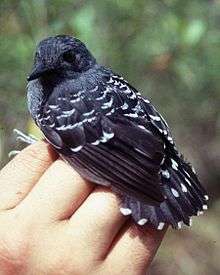 | |
| Male, Cordillera del Cóndor, Ecuador | |
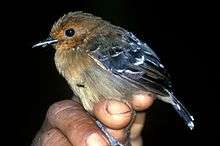 | |
| Female, Cordillera del Cóndor, Ecuador | |
| Scientific classification | |
| Kingdom: | Animalia |
| Phylum: | Chordata |
| Class: | Aves |
| Order: | Passeriformes |
| Family: | Thamnophilidae |
| Genus: | Willisornis |
| Species: | W. poecilinotus |
| Binomial name | |
| Willisornis poecilinotus (Cabanis, 1847) | |
| Synonyms | |
| |
The scale-backed antbird (Willisornis poecilinotus)[1] is a species of bird in the family Thamnophilidae, the antbirds. It has often been included in the genus Hylophylax, but is now known to be part of a different clade, leading to its placement in the genus Willisornis. It was briefly placed in Dichropogon, but this name is preoccupied by a genus of asilid flies (Dichropogon Bezzi, 1910).[2][3] It formerly included the Xingu antbird as a subspecies.[4]
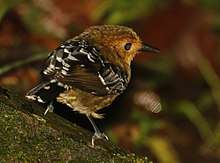
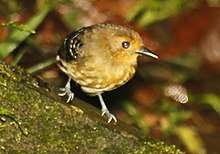
It is found in the Amazon of Bolivia, Brazil, Colombia, Ecuador, French Guiana, Guyana, Peru, Suriname, and Venezuela. Its natural habitat is tropical moist lowland forests. As many other species of antbirds, it regularly follows swarms of army ants.
In addition to being sexually dimorphic, the plumages of the subspecies are highly variable, leading to speculations that the scale-backed antbird as presently defined may include more than a single species. Males of all subspecies, and females of some (but not all) subspecies have white bars on the back, leading to its common name scale-backed antbird.
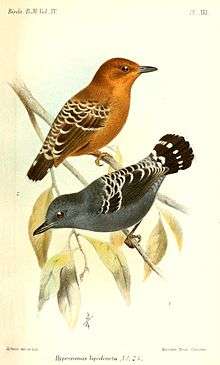
References
- ↑ ENGLISH NAME UPDATES - IOC Version 2.9 (July 10, 2011), IOC World Bird List
- ↑ Revive the genus Dichropogon - South American Classification Committee (2007)
- ↑ Reassign Dichropogon to Willisornis - South American Classification Committee (2008)
- ↑ Isler & Whitney (2011). Species limits in antbirds (Thamnophilidae): The Scale-backed Antbird (Willisornis poecilinotus) complex. Wilson Journal of Ornithology 123(1): 1-14
- BirdLife International 2004. Hylophylax poecilinotus. 2006 IUCN Red List of Threatened Species. Downloaded on 26 July 2007.
- Agne, C.E.Q. & Pacheco, J.F. 2007. A homonymy in Thamnophilidae: a new name for Dichropogon Chubb. Revista Brasileira de Ornitologia 15 (3): 484-485
External links
| Wikimedia Commons has media related to Willisornis poecilonotus. |
| Wikispecies has information related to: Hylophylax poecilinotus |
- Scale-backed antbird photo gallery VIREO
- Photo; Article chandra.as.utexas.edu
